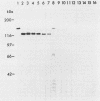Abstract
A total of 192 hybridomas were developed from mice immunized with Rickettsia japonica, a newly identified spotted fever group rickettsia pathogenic for humans. Of these hybridomas, 101 were species specific, 37 were spotted fever group reactive, and the other 54 were also reactive with one or more of the other pathogenic species of spotted fever group rickettsiae, Rickettsia akari, Rickettsia australis, Rickettsia conorii, Rickettsia rickettsii, and Rickettsia sibrica. Seven of the species-specific monoclonal antibodies were characterized. These monoclonal antibodies all belong to the immunoglobulin G class and react with all five strains of R. japonica at the same immunofluorescence titers, indicating that the five strains all belong to a single species. The species-specific epitopes reactive with these monoclonal antibodies are located on the surface proteins of the organisms demonstrated as 145- and 120-kilodalton bands on Western immunoblots. These two antigenic bands were shown to be proteins, because treatment with proteinase K completely destroyed the reactivity of the bands with the monoclonal antibodies.
Full text
PDF



Images in this article
Selected References
These references are in PubMed. This may not be the complete list of references from this article.
- Anacker R. L., List R. H., Mann R. E., Hayes S. F., Thomas L. A. Characterization of monoclonal antibodies protecting mice against Rickettsia rickettsii. J Infect Dis. 1985 Jun;151(6):1052–1060. doi: 10.1093/infdis/151.6.1052. [DOI] [PubMed] [Google Scholar]
- Anacker R. L., List R. H., Mann R. E., Wiedbrauk D. L. Antigenic heterogeneity in high- and low-virulence strains of Rickettsia rickettsii revealed by monoclonal antibodies. Infect Immun. 1986 Feb;51(2):653–660. doi: 10.1128/iai.51.2.653-660.1986. [DOI] [PMC free article] [PubMed] [Google Scholar]
- Anacker R. L., Mann R. E., Gonzales C. Reactivity of monoclonal antibodies to Rickettsia rickettsii with spotted fever and typhus group rickettsiae. J Clin Microbiol. 1987 Jan;25(1):167–171. doi: 10.1128/jcm.25.1.167-171.1987. [DOI] [PMC free article] [PubMed] [Google Scholar]
- Feng H. M., Walker D. H., Wang J. G. Analysis of T-cell-dependent and -independent antigens of Rickettsia conorii with monoclonal antibodies. Infect Immun. 1987 Jan;55(1):7–15. doi: 10.1128/iai.55.1.7-15.1987. [DOI] [PMC free article] [PubMed] [Google Scholar]
- Kaiho I., Tokieda M., Ohtawara M., Uchiyama T., Uchida T. Occurrence of rickettsiosis of spotted fever group in Chiba Prefecture of Japan. Jpn J Med Sci Biol. 1988 Apr;41(2):69–71. doi: 10.7883/yoken1952.41.69. [DOI] [PubMed] [Google Scholar]
- Laemmli U. K. Cleavage of structural proteins during the assembly of the head of bacteriophage T4. Nature. 1970 Aug 15;227(5259):680–685. doi: 10.1038/227680a0. [DOI] [PubMed] [Google Scholar]
- Li H., Lenz B., Walker D. H. Protective monoclonal antibodies recognize heat-labile epitopes on surface proteins of spotted fever group rickettsiae. Infect Immun. 1988 Oct;56(10):2587–2593. doi: 10.1128/iai.56.10.2587-2593.1988. [DOI] [PMC free article] [PubMed] [Google Scholar]
- McDade J. E., Black C. M., Roumillat L. F., Redus M. A., Spruill C. L. Addition of monoclonal antibodies specific for Rickettsia akari to the rickettsial diagnostic panel. J Clin Microbiol. 1988 Oct;26(10):2221–2223. doi: 10.1128/jcm.26.10.2221-2223.1988. [DOI] [PMC free article] [PubMed] [Google Scholar]
- Philip R. N., Casper E. A., Burgdorfer W., Gerloff R. K., Hughes L. E., Bell E. J. Serologic typing of rickettsiae of the spotted fever group by microimmunofluorescence. J Immunol. 1978 Nov;121(5):1961–1968. [PubMed] [Google Scholar]
- Uchida T., Mahara F., Tsuboi Y., Oya A. Spotted fever group rickettsiosis in Japan. Jpn J Med Sci Biol. 1985 Jun;38(3):151–153. doi: 10.7883/yoken1952.38.151. [DOI] [PubMed] [Google Scholar]
- Uchida T., Tashiro F., Funato T., Kitamura Y. Isolation of a spotted fever group Rickettsia from a patient with febrile exanthematous illness in Shikoku, Japan. Microbiol Immunol. 1986;30(12):1323–1326. doi: 10.1111/j.1348-0421.1986.tb03053.x. [DOI] [PubMed] [Google Scholar]
- Uchida T., Uchiyama T., Koyama A. H. Isolation of spotted fever group rickettsiae from humans in Japan. J Infect Dis. 1988 Sep;158(3):664–665. doi: 10.1093/infdis/158.3.664-a. [DOI] [PubMed] [Google Scholar]
- Uchida T., Yu X. J., Uchiyama T., Walker D. H. Identification of a unique spotted fever group rickettsia from humans in Japan. J Infect Dis. 1989 Jun;159(6):1122–1126. doi: 10.1093/infdis/159.6.1122. [DOI] [PubMed] [Google Scholar]
- Uchiyama T., Uchida T. Ultrastructural study on Japanese isolates of spotted fever group rickettsiae. Microbiol Immunol. 1988;32(11):1163–1166. doi: 10.1111/j.1348-0421.1988.tb01479.x. [DOI] [PubMed] [Google Scholar]
- Wang J. G., Walker D. H. Identification of spotted fever group rickettsiae from human and tick sources in the People's Republic of China. J Infect Dis. 1987 Oct;156(4):665–669. doi: 10.1093/infdis/156.4.665. [DOI] [PubMed] [Google Scholar]
- Yamamoto S., Kawabata N., Uchiyama T., Uchida T. Evidence for infection caused by spotted fever group Rickettsia in Kyushu, Japan. Jpn J Med Sci Biol. 1987 Apr;40(2):75–78. doi: 10.7883/yoken1952.40.75. [DOI] [PubMed] [Google Scholar]





